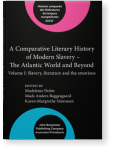Chapter 16
Fear and love in Matanzas
Emotional extremis in the works of Juan Franciso Manzano
Many of the most gripping scenes in the first-person account of life under slavery by the
19th-century Cuban poet Juan Francisco Manzano reference pleasures and punishments involving the exercise of the
emotions. His works in both narrative and verse strikingly foreground emotional duress as a central and lasting
product of the psychosocial and physical abuse that characterized enslavement. Denied the free expression of his own
senses and emotions, his autobiographical protagonist is at the same time subject to the degraded sensory indulgences
of overseers and others who force him to participate in acts that perpetuate his own harm. In the dramatic
representation of these traumatic episodes, Manzano notes how his natural liveliness, bonhomie and even affection for
those around him were gradually replaced by overwhelming melancholy and foreboding.
Article outline
- The battlefield of the senses
- Trembling, salutation and surprise
- A garden of happiness
- Certain states of depression, incurable to this day
- From lamb to lion
-
Notes
-
References
This content is being prepared for publication; it may be subject to changes.
